The annual International Space Station marathon viewing season begins later this week, when skywatchers in the Northern Hemisphere can watch up to five ISS passes in one night.
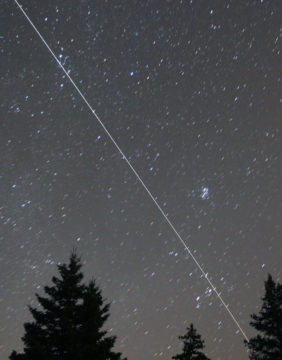
Bob King
I've seen the International Space Station (ISS) pass over my house a hundred times yet never tire of the sight. Inside that bright light, a crew of several astronauts looks earthward with the same sense of wonder. Now in its 21st year in orbit, the ISS is the brightest, most recognizable satellite in the sky. Few naked-eye sky sights elicit more wows at public star parties than the Venus-bright "star" speeding through the constellations.
Thanks to the steep 51.6° inclination of its orbit, the station passes overhead for anyone living between latitudes 51.6°N and 51.6°S. It's visible at least 10° above the horizon between 63°N and 63°S as well, guaranteeing that nearly every person on Earth has a chance to see it.
ISS "viewing seasons" are cyclic, with each lasting several weeks. You might first spot it in the evening sky, very low in the south, as it makes a single pass a night. The altitude and number of passes increases nightly and then tapers off, to be followed by a period of daytime-only passes until it reappears at dawn. From dawn the station transitions back to the evening sky to begin a new cycle.
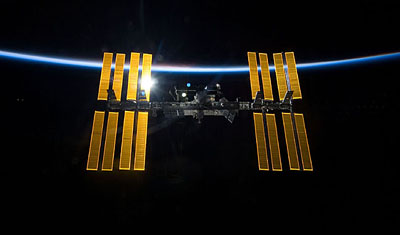
NASA
Some mornings or evenings we see only a single appearance, but if you're diligent you can often catch two: a long, bright pass preceded or followed by a fainter partial pass. "Partials" occur when the space station glides into in the cover of Earth’s shadow and fades from view.
Like the Moon does on occasion, the ISS passes into eclipse, but does so routinely because our planet's shadow covers much more sky at the station's 406-km altitude. The ship's orbital period is also more than 400 times shorter than the Moon's, so it's in and out of shadow 16 times a day.
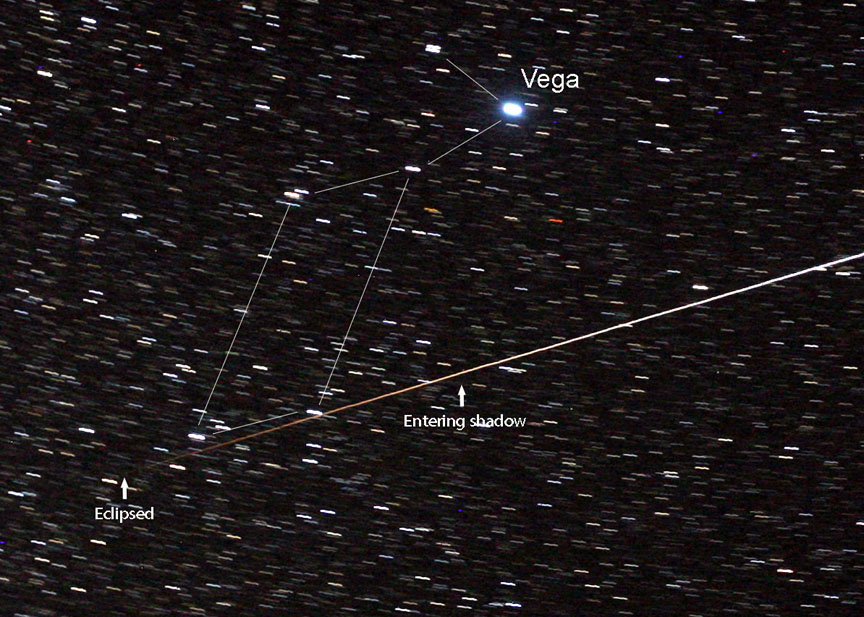
Bob King
Watching the ISS move into eclipse makes for exciting viewing. Have a pair of binoculars at the ready to watch the ship fade and redden as it slides into Earth's shadow. From the perspective of the astronauts, the Sun is setting at the station, so the ISS takes on a sunset hue for a few seconds as it races into shadow.
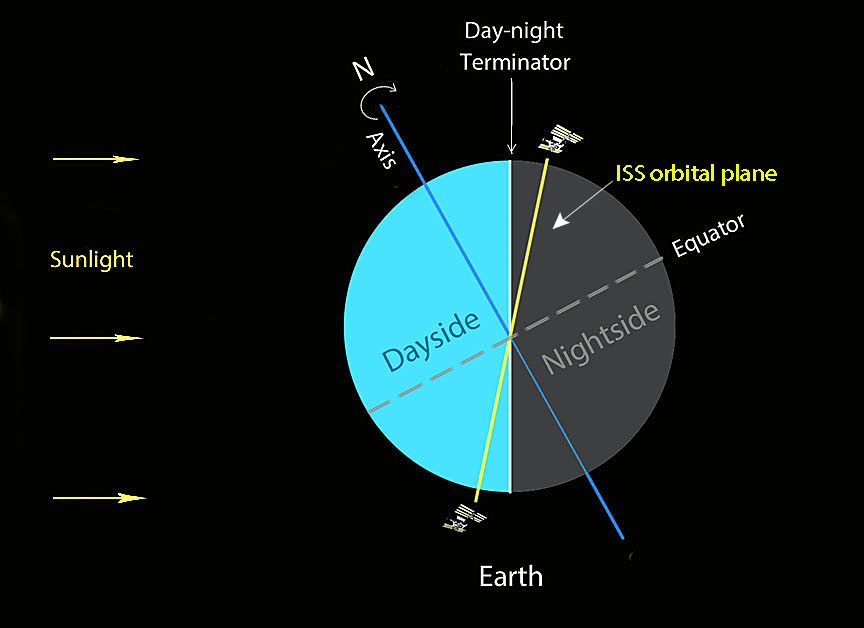
Bob King
Each year within a few weeks of summer solstice in either hemisphere, the space station’s orbit and Earth’s day–night terminator nearly align. For a few days and nights the Sun never sets on the ISS. Like seeing the "midnight Sun" at the Arctic Circle on the first day of summer, astronauts and their craft bask in sunlight 24/7. The Northern Hemisphere season happens between May and July; southern observers get their turn between November and January. This year's brief season begins on Friday, May 17th, and wraps up on the 20th.
In late May–early June near the summer solstice, the Sun doesn’t set on the International Space Station
Depending on your location you may see up to five successive passes of the ISS during that time. Go out at dusk to catch the easy early ones and stay up till dawn for the rest. Someone should really be giving out certificates to anyone who achieves this sleep-defying feat. Maybe something for the Astronomical League to consider? Some places get six passes during a 24-hour period: 3–4 in the early morning followed by 2–3 appearances that evening.
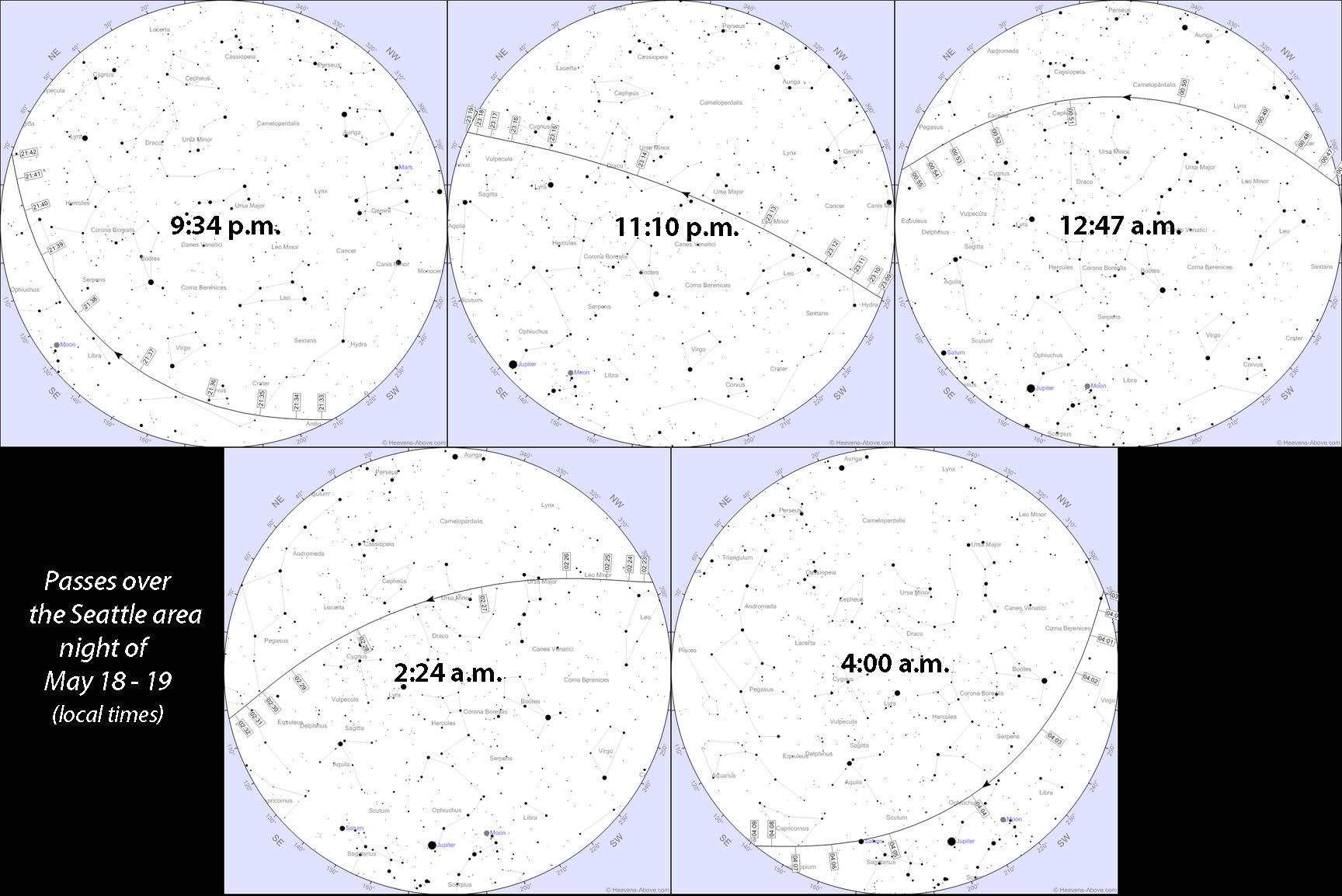
Chris Peat / Heavens Above
Of course you'll need to know exactly when and where to look. You can find the space station and get a map showing its path for your location at Heavens Above. Click the link, select your city, and then tap the ISS link for a list of passes in the coming nights. Click on a date to see a map and timeline. Or go to NASA’s Spot the Station site for times, where you can also sign up to get e-mail or text alerts whenever there's a favorable pass for your city. Apps are great, too, especially when they're free. Try ISS Spotter for iPhone and ISS Detector for Android.
What to Anticipate
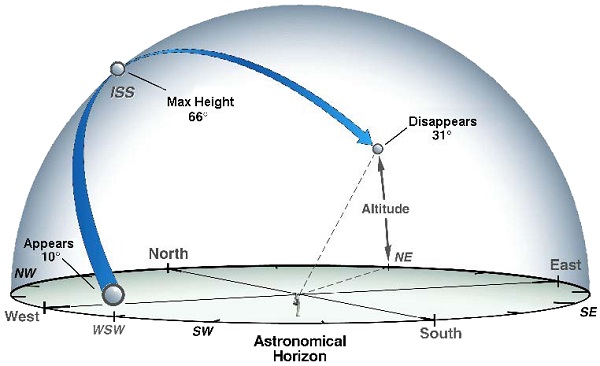
NASA / Spot the Station
The ISS orbits the Earth from west to east to take advantage of the planet's rotation, so it always rises in the west and tracks east. When low, the ISS is fainter than when overhead because of the added line-of-sight distance. It shines brightest east of the zenith, when the station is both close and also nearly opposite the Sun and lit up like a little full Moon. Here are some cool things to watch for in addition to the aforementioned sunsets and sunrises:
- Flares — Occasionally, sunlight will strike the arrays or an area on the station at just the right angle to reflect back to your eyes, causing the ISS to briefly flare in brightness.
- Jerky Movements — If you watch the ISS or any satellite closely it will appear to move jerkily as it crosses the sky. What you’re really seeing are your own jerky eye movements transposed on the sky. Our peepers are not well-oiled machines.
- Conjunctions — At Heavens Above you can get a map of any pass and note when the station crosses in front of or passes very close to a bright star or planet. Jupiter's a favorite and now gleams in the southeast around 10 p.m. local time.
- Beautiful Dumps — Astronauts have to occasionally dump wastewater outside the station which immediately crystallizes and expands into a cloud. If you ever look up to discover the ISS has a tail like a comet, you're witnessing a dump.
- Telescopic Revelations — With only a little practice you can center and follow the ISS in a low-power telescope. I anticipate its path while looking through my finderscope then quickly move to the eyepiece to track it. Once held in view, the solar arrays are easy to see at 60×, and you can even make out shapes in the station proper.
- Shareworthy Photos — You'll need a tripod and the ability to take a 15-second or longer exposure. Get a map from Heavens Above so you know where to point the camera. Set your lens and exposure to manual (M). Pre-focus on a bright star using the camera's Live View feature. If you don't know how to use it, click here for a great tutorial. Next, set the ISO for 800 or 1600 and open your lens up to f/2.8 or f/4. Most cameras cut off at 30 seconds of exposure, so you'll only get a segment of the ISS's complete path. For exposures longer than 30 seconds, either carefully hold down the shutter button or use a remote release that will keep the shutter open with a simple click. When using the release, don't forget to turn your shutter speed knob to “B," which allows for unlimited time exposures. Do a test exposure in advance to check the result.
Even if you get hit with cloudy weather this week, the space station will continue to make passes through early June. The next series of 24/7 sunlit passes begins in mid-July.
 12
12









Comments
Anthony Barreiro
May 16, 2019 at 3:24 pm
Watching the ISS disappear into the Earth's shadow in the evening can give me a felt sense of the height of the station's orbit. For pure drama, I love seeing the ISS suddenly appear high in the western dawn sky, blazing as brightly as Venus.
You must be logged in to post a comment.
Zé-De Boni
May 18, 2019 at 11:41 am
Chris Peat, Fred Espenak... They lead my list of people who deserve a prize as high as the Nobel in recognition of their valuable works that turn easy to find precise technical information and therefore contribute to the dissemination of scientific knowledge. S&T is surely in that list too.
You must be logged in to post a comment.
Bob KingPost Author
May 21, 2019 at 1:20 am
Ze,
Totally agree on your choices and sentiment, and we're honored to be included in it, too!
You must be logged in to post a comment.
Brad Lutts
May 17, 2019 at 5:44 pm
It was always inspiring to watch the STS shuttles pursue and catch the ISS. Viewings seemed particularly bright when they were docked together. Two great programs.
You must be logged in to post a comment.
Joe Stieber
May 18, 2019 at 2:28 pm
Here at 40°N-75°W (near Philadelphia), we had a chance of seeing six (6) ISS passes last night, May 17-18, 2019. Alas, even though the Clear Sky Chart looked promising, there was a passing rain shower just before the first pass and it was still cloudy for the second pass, so I gave up.
Tonight, May 18-19, we have a chance of seeing five (5) passes, and again, the CSC looks promising (although not ideal). I'll be on standby in case the weather actually cooperates. And tonight's full moon won't be an impediment like it can be for so many other observing projects!
Last year, I was able to see six (6) ISS passes on the night of May 21-22, 2018, and on the final pass, also saw the Cygnus cargo spacecraft (with binoculars). It was launched earlier in the day, and when spotted, it was about 5 minutes behind the ISS on the same track. The following night was cloudy, but on the night of May 23-24, I saw all four (4) visible ISS passes, and in each case, the ISS was followed by Cygnus 15 to 5 seconds behind. The gap was shrinking as the Cygnus docked later in the morning.
As always, thanks to Bob for another informative observing article, much appreciated by this ardent visual observer. And thanks too to Chris Peat for his Heavens-Above web site. After a couple of decades, it's still my go-to site for satellite pass predictions. In front of me now, I have a printout of the upcoming ISS passes, with a highlighter marking tonight's times and positions. I've also noted tonight's sunset, sunrise and twilight times from the U.S. Naval Observatory's MICA software.
You must be logged in to post a comment.
Dobsonite
May 20, 2019 at 12:12 am
While most of the US was being washed away, tornadoed and wind stormed out, here in Orange County, CA, we were merely T-Storm-celled out. My wife had the good fortune to see the ISS for about 5 seconds in a "sucker hole" through the wrack, but she did, and I was looking in the wrong place! Bananas!!
Well, like I said above, I had plenty of company.
Hope next time the ISS comes over our Barbarian Urban Jungle I'll get to see it.
Don't feel bad for us, since 1996 we've seen Hyakutake from a 8000 ft. mountain, SL9, and HALE-BOPP. This has been truly a remarkable era for "looking up".
You must be logged in to post a comment.
Joe Stieber
May 25, 2019 at 1:47 pm
A belated report...
On the night of May 18-19, 2019, I managed to see four of the five visible ISS passes. The first, peaking about 9:31 pm EDT, was high and bright and I could see a rectangular shape in my 15x56 binoculars. The next two passes, peaking at 11:08 pm and 12:45 am, were lower in the north and not as bright, but still easily spotted with unaided eyes. By the time of the fourth pass, peaking about 2:23 am, some clouds had moved in and this pass was seen for only about 10 seconds with the 15x56s through a thin patch in the clouds. By the time of the fifth pass, peaking about 4:00 am, it was completely overcast, so the ISS was not seen (it would have been a high and bright pass).
On the night of May 19-20, 2019, there were six visible ISS passes on the schedule. Alas, it was cloudy enough that I didn't even try spotting them.
You must be logged in to post a comment.
Bob KingPost Author
May 26, 2019 at 12:05 pm
Very impressed, Joe. What time did you wake up the next morning ... or afternoon?!
You must be logged in to post a comment.
Joe Stieber
May 26, 2019 at 5:04 pm
Thanks Bob!
I think I got up around the crack of noon, but since I'm retired, it's not a problem keeping astronomical hours.
You must be logged in to post a comment.
Bob KingPost Author
May 27, 2019 at 10:45 am
Joe,
Yes, that bit of astronomical freedom is a joy.
You must be logged in to post a comment.
Rajainayat
April 29, 2020 at 5:34 pm
Wow i am so excited and wanted to share that i first time ever watched the ISS in the skies with precisely pin pointing by the ISS android app and now i can watch regularly with alerts of ISS app . Ammazing technology which also gives a complete virtual tour of ISS and also the live stream of ISS. love to be part of ISS community.
You must be logged in to post a comment.
Bob KingPost Author
April 30, 2020 at 12:18 am
Dear Rajainayat,
I sense your excitement. Watching the ISS never gets old!
You must be logged in to post a comment.
You must be logged in to post a comment.